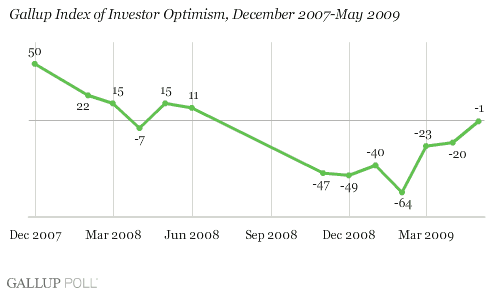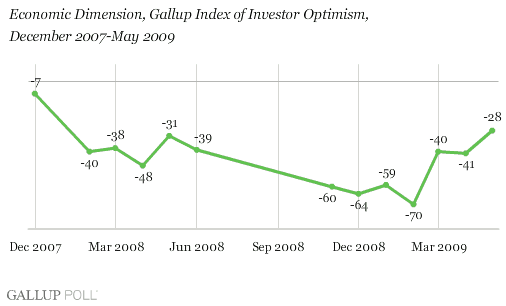PRINCETON, NJ -- The ���۴�ýIndex of Investor Optimism -- a broad measure of investor perceptions -- surged 19 points in May to -1, indicating that investors are now essentially neutral on the future direction of the economy. The Index has improved 63 points from February's -64 reading, which is the lowest for the Index since its 1996 inception.

Portfolio Optimism Improves
Investors' expectations for their personal portfolios over the next 12 months improved in May, as the Personal Dimension of the Index increased by six points to 27. This is the highest level of personal optimism for investors this year, and suggests that after the sharp improvement in the equities markets, investors remain cautiously optimistic about the performance of their personal portfolios over the next 12 months.

Economic Optimism Improves
Investor optimism about the U.S. economy's direction over the next 12 months also improved in May, as the Economic Dimension surged 13 points to -28. While investors as a group remain pessimistic about the economic outlook, they are much less so than they were in February, when this dimension was at -70. In fact, investor optimism about the economic outlook is at its best level since December 2007 -- essentially when the current recession began.

Commentary
The sharp improvement in investor confidence in May and its overall surge since February is consistent with . Further, while investors' and consumers' expectations have improved greatly over the past several months, both groups remain somewhat pessimistic about the economic outlook for the next 12 months.
The reality on Main Street is that the economy remains weak, with new jobless claims in the 600,000 range and the U.S. unemployment rate at 9.4% and rising. And while retail sales increased a little in May, it is not reassuring that this was in large part the result of another sharp increase in gas prices. There are clearly strong head winds facing today's very fragile economy and its chances for recovery, given the recent surges in interest rates and gas prices at the pump.
Gallup's Index of Investor Optimism suggests that those on Wall Street expecting a sharp upturn in the U.S. economy later this year may be out in front of not only the American consumer but also the average investor. Gallup's Monitor of Consumer Spending would tend to support the views of Main Street consumers and investors.
Author's note: Gallup's Index of Investor Optimism -- a survey of those having $10,000 or more of investable assets -- peaked at 178 in January 2000, just prior to the bursting of the dot-com bubble. Last year, the Index turned negative for the first time in its history. Before last year, the low for the Index was 5 in March 2003, reflecting investor concerns at the outset of the Iraq war.
Survey Methods
���۴�ýPoll Daily tracking includes no fewer than 1,000 U.S. adults interviewed nationwide each day during 2008. The Index of Investor Optimism results are based on questions asked of 1,000 or more investors over a three-day period each month, conducted May 26-28, April 21-23, March 16-18, Feb. 17-19, and Jan. 16-18, 2009; and Dec. 16-18, Nov. 24-26, June 3-6, April 25-28, March 28-31, and Feb. 28-March 2, 2008. For results based on these samples, the maximum margin of sampling error is ±3 percentage points.
Results for May 2008 are from a ���۴�ýPanel study and are based on telephone interviews with 576 national adults, aged 18 and older, conducted May 19-21, 2008. ���۴�ýPanel members are recruited through random selection methods. The panel is weighted so that it is demographically representative of the U.S. adult population. For results based on this sample, one can say with 95% confidence that the maximum margin of sampling error is ±5 percentage points.
For investor results prior to 2008, telephone interviews were conducted with at least 800 investors, aged 18 and older, and having at least $10,000 of investable assets. For the total sample of investors in these surveys, one can say with 95% confidence that the maximum margin of sampling error is ±4 percentage points.
Interviews are conducted with respondents on land-line telephones (for respondents with a land-line telephone) and cellular phones (for respondents who are cell-phone only).
In addition to sampling error, question wording and practical difficulties in conducting surveys can introduce error or bias into the findings of public opinion polls.
